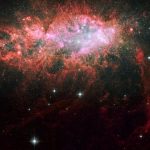Canadian scientists trace 2nd strange radio signal to nearby galaxy0
- From Around the Web, Space
- January 20, 2020
Found in different galaxy than 1st signal, astronomers 1 step closer to finding out where these bursts thrive

Found in different galaxy than 1st signal, astronomers 1 step closer to finding out where these bursts thrive

Things are only getting more confusing.

A trio of galaxies has been caught ionizing hydrogen 680 million years after the Big Bang

Of all the galaxies observed by astronomers, barely any are as strange or geometrically unique as Hoag’s Object.

The newly found outliers defy ideas of how these star systems evolve

An international team of astronomers has discovered a massive cloud of gas that formed just 850 million years after the Big Bang. The chemical composition of the object reveals that the first generation of stars formed quickly and enriched the Universe with the elements they synthesized.

Harsh ultraviolet radiation suggests how hydrogen got ionized in the universe long ago

A super telescope has begun the most detailed survey of the Universe ever undertaken.

The universe contains somewhere in the ballpark of 100 billion and 200 billion galaxies. With numbers that large, you can bet that there are some real weirdos out there. Out beyond our Milky Way, there are galaxies shaped like jellyfish, galaxies that consume other galaxies, and galaxies that seem to lack the dark matter that pervades the rest of the universe.

Astronomers know that most galaxies house supermassive black holes in their centers, from the largest galaxies down to small dwarfs.